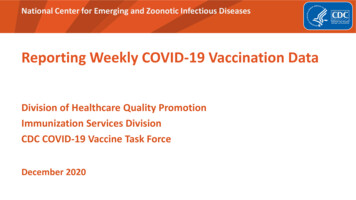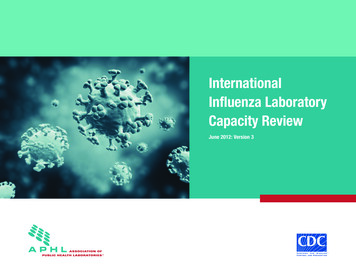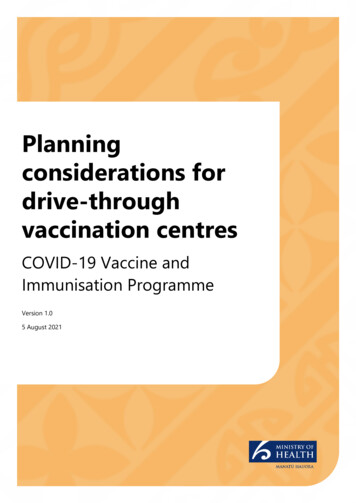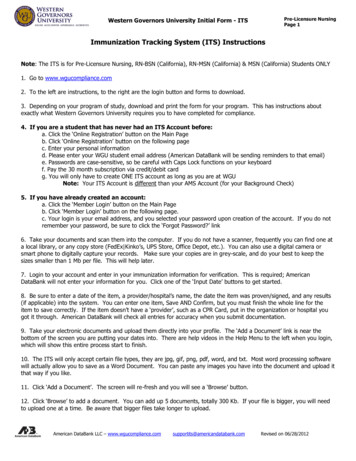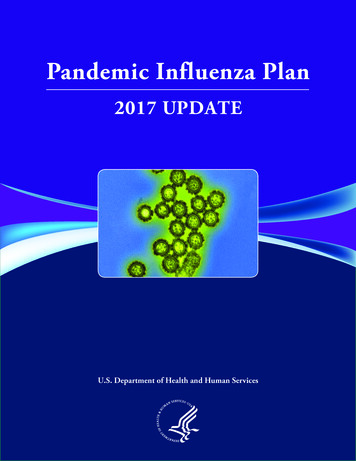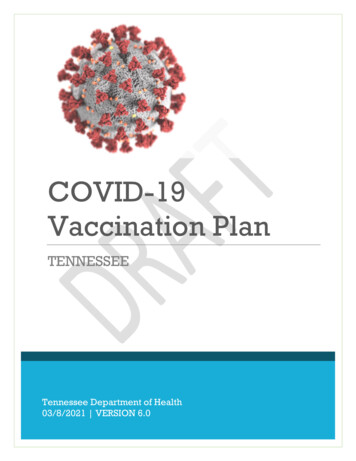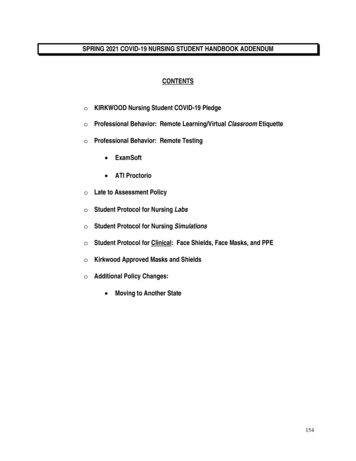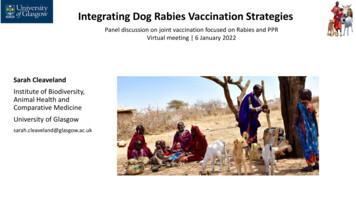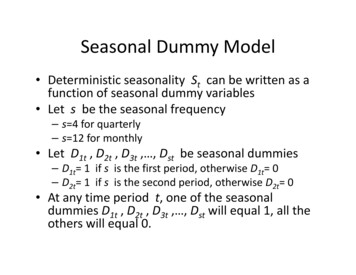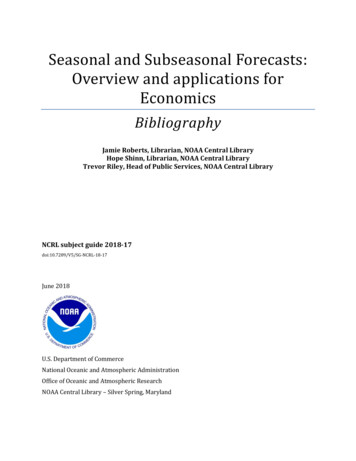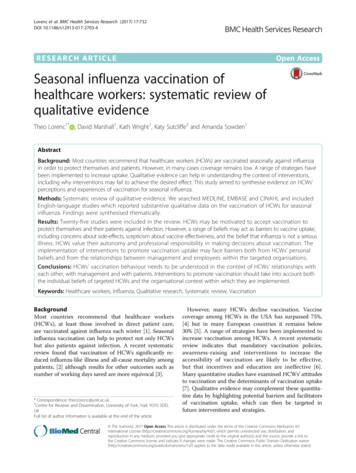
Transcription
Lorenc et al. BMC Health Services Research (2017) 17:732DOI 10.1186/s12913-017-2703-4RESEARCH ARTICLEOpen AccessSeasonal influenza vaccination ofhealthcare workers: systematic review ofqualitative evidenceTheo Lorenc1* , David Marshall1, Kath Wright1, Katy Sutcliffe2 and Amanda Sowden1AbstractBackground: Most countries recommend that healthcare workers (HCWs) are vaccinated seasonally against influenzain order to protect themselves and patients. However, in many cases coverage remains low. A range of strategies havebeen implemented to increase uptake. Qualitative evidence can help in understanding the context of interventions,including why interventions may fail to achieve the desired effect. This study aimed to synthesise evidence on HCWs’perceptions and experiences of vaccination for seasonal influenza.Methods: Systematic review of qualitative evidence. We searched MEDLINE, EMBASE and CINAHL and includedEnglish-language studies which reported substantive qualitative data on the vaccination of HCWs for seasonalinfluenza. Findings were synthesised thematically.Results: Twenty-five studies were included in the review. HCWs may be motivated to accept vaccination toprotect themselves and their patients against infection. However, a range of beliefs may act as barriers to vaccine uptake,including concerns about side-effects, scepticism about vaccine effectiveness, and the belief that influenza is not a seriousillness. HCWs value their autonomy and professional responsibility in making decisions about vaccination. Theimplementation of interventions to promote vaccination uptake may face barriers both from HCWs’ personalbeliefs and from the relationships between management and employees within the targeted organisations.Conclusions: HCWs’ vaccination behaviour needs to be understood in the context of HCWs’ relationships witheach other, with management and with patients. Interventions to promote vaccination should take into account boththe individual beliefs of targeted HCWs and the organisational context within which they are implemented.Keywords: Healthcare workers, Influenza, Qualitative research, Systematic review, VaccinationBackgroundMost countries recommend that healthcare workers(HCWs), at least those involved in direct patient care,are vaccinated against influenza each winter [1]. Seasonalinfluenza vaccination can help to protect not only HCWsbut also patients against infection. A recent systematicreview found that vaccination of HCWs significantly reduced influenza-like illness and all-cause mortality amongpatients, [2] although results for other outcomes such asnumber of working days saved are more equivocal [3].* Correspondence: theo.lorenc@york.ac.uk1Centre for Reviews and Dissemination, University of York, York YO10 5DD,UKFull list of author information is available at the end of the articleHowever, many HCWs decline vaccination. Vaccinecoverage among HCWs in the USA has surpassed 75%,[4] but in many European countries it remains below30% [5]. A range of strategies have been implemented toincrease vaccination among HCWs. A recent systematicreview indicates that mandatory vaccination policies,awareness-raising and interventions to increase theaccessibility of vaccination are likely to be effective,but that incentives and education are ineffective [6].Many quantitative studies have examined HCWs’ attitudesto vaccination and the determinants of vaccination uptake[7]. Qualitative evidence may complement these quantitative data by highlighting potential barriers and facilitatorsof vaccination uptake, which can then be targeted infuture interventions and strategies. The Author(s). 2017 Open Access This article is distributed under the terms of the Creative Commons Attribution 4.0International License (http://creativecommons.org/licenses/by/4.0/), which permits unrestricted use, distribution, andreproduction in any medium, provided you give appropriate credit to the original author(s) and the source, provide a link tothe Creative Commons license, and indicate if changes were made. The Creative Commons Public Domain Dedication o/1.0/) applies to the data made available in this article, unless otherwise stated.
Lorenc et al. BMC Health Services Research (2017) 17:732The aim of this systematic review was to synthesiseevidence on HCWs’ perceptions and experiences ofvaccination for seasonal influenza. It was commissionedby the Department of Health in England to inform thedevelopment of policy on vaccination of HCWs. Weused a systematic approach, with pre-defined inclusioncriteria and a reproducible methodology. However, dueto the need to provide a timely synthesis of the evidencefor policy decision-making, we streamlined our approachto data analysis, which was conducted by a single reviewer and focused on the identification of key themes,rather than on producing a critical synthesis or developing third-order constructs. Further interpretations of thedata are explored in the discussion below.MethodsWe followed CRD Guidance on Undertaking SystematicReviews [8].SearchingWe searched MEDLINE, EMBASE and CINAHL inMay–June 2016. The search strategy took the form:(terms for HCWs) AND (terms for vaccination) AND(terms for influenza) AND (terms for views and qualitativeresearch).The full MEDLINE search strategy is presented in webonly Additional file 1. No date or language restrictions wereapplied to the search. We searched Google using simplifiedforms of the search strategy and scanned the first 100 results, and manually searched websites of key organisationsincluding NHS Employers, Centers for Disease Controland Prevention and the World Health Organization.We screened a recently published review evaluating theeffectiveness of interventions to increase influenza vaccine uptake for any linked qualitative data [6]. We scannedthe lists of included studies of potentially relevant systematic reviews identified by the search, and the reference listsof all included studies. We carried out forward citationchasing on all included studies using Google Scholar.ScreeningA 10% sample of abstracts was screened by two reviewersindependently and differences resolved by discussion.Agreement on inclusion for this sample was 99.4% (κ 0.66). The remaining 90% were screened by a single reviewer. The following inclusion criteria were applied:1)2)3)4)5)Qualitative researchStudy reports data on seasonal influenza vaccinationStudy includes HCWsStudy published in English(full-text only) Study reports substantive qualitativedata (i.e., more than one or two relevant data points,or a very brief summary of findings)Page 2 of 8All full-text studies were screened by two reviewersindependently and differences resolved by discussion.Quality assessment, data extraction and synthesisWe used Hawker et al.’s tool to assess study quality [9].Quality assessment was carried out by one reviewer andchecked in detail by a second reviewer. Data were extracted on the methodology and characteristics of thestudy, including: research question; sampling and recruitment; study population; data collection; and dataanalysis. We used a thematic analysis methodology forthe synthesis of qualitative data [10]. Thematic qualitative data were coded from the findings of the studies,including quotes from participants and study authors’interpretations. The themes were then inductively organised under headings for reporting. Data extraction,coding and synthesis were carried out by a single reviewer. EPPI-Reviewer 4 software was used to managedata [11].ResultsFlow of literature through the reviewThe flow of literature through the review process is shownin Fig. 1. A total of 3399 references were screened, whichresulted in a total of 25 studies being included in thereview, reported in 29 publications.Characteristics and quality of the studiesThe results of quality assessment are shown in Additionalfile 2. The quality of the studies overall was mixed, withlow scores particularly on the domains of sampling, ethicsand bias, and transferability.Tables 1 and 2 provide an overview of the studies. Table 1shows those studies which collected data from HCWsabout their own views of vaccination. Table 2 showsstudies which included people delivering interventions,including infection control or occupational health staff,senior managers and administrators; some of these studiesalso included other stakeholders such as representatives ofprofessional bodies, but none asked HCWs about theirown views.Most studies were carried out in the USA, Canada orAustralia. The most commonly studied healthcare setting was hospitals or acute care facilities, followed bynursing homes or long-term care. Of the studies whichlooked at HCWs’ own views, eleven included a range ofdifferent HCW roles, while five focused specifically onnurses.The thematic data were organised under the followingheadings for synthesis: beliefs about influenza, such as the risks andconsequences of contracting influenza;
Lorenc et al. BMC Health Services Research (2017) 17:732Page 3 of 8Fig. 1 Flow of literature through the review beliefs about the vaccine, such as effectiveness andBeliefs about vaccineside-effects; ethical and organisational issues; and perceptions relating to interventions to promotevaccination.Many participants believed the vaccine was effective,and cited as reasons to accept vaccination: protecting patients against infection, particularly vulnerablegroups such as older or immuno-compromised patients;[12, 14, 16–20, 22–24, 26–29] protecting their own health[12, 14–17, 19, 20, 22–24, 28, 29] or that of their families;[12–17, 22, 23, 28] and avoiding time off work [12, 14–18,23, 24, 29]. Few participants mentioned herd immunity orpopulation health [16, 17, 26]. Authors of several studiessuggested that the balance of the data showed selfprotection to be a more important motivator than theprotection of patients [14, 15, 20, 22–24]. Several participants argued that vaccination is implied by the commitment to patient wellbeing which is a basic part of HCWs’professional ethos: [12, 17, 26, 28] “[I]t’s the HippocraticOath. The first thing you do is ‘do no harm’ and if you’recarrying around flu germs from patient to patient, you’redoing harm” (participant [12]).By contrast, other participants expressed a beliefthat the vaccine is not effective in preventing influenza[13–25, 30, 31]. Some participants pointed to the mutation of the virus and the possible mismatch of vaccinestrains as reasons why the vaccine is sometimes ineffective[14, 15, 20, 23]. Some suggested that the scientific evidence on the effectiveness of the vaccine was insufficientto provide a convincing case for vaccination programmes:[18, 24, 31] “I think it’s the skeptics that in actual fact arespecifically the medical staff who are very analyticalBeliefs about influenzaMany participants perceived themselves as at low risk ofcontracting influenza as they are healthy or ‘never getsick’ [12–25]. Some argued that they have a strong immune system due to working in healthcare and being exposed to infection [15, 18, 19, 23]. Several studies reporteda perception that high-risk populations comprise olderpeople and people with chronic illnesses, not healthyworking-age adults: [14–16, 19, 20, 22, 25] “what peopleget from the advertisements is you really only need it ifyou’re sick or in the nursing home or you have a lot ofhealth issues” (participant [25]). Few participants described themselves as at high risk, [16, 17, 19, 22] althoughsome participants cited having chronic illnesses such asasthma as a reason to receive vaccination [14, 16, 17, 22].In some studies, HCWs estimated that they were unlikely to transmit influenza to patients, [15, 16, 19, 20, 22]and a few suggested that patients are more likely to catchinfluenza from other patients than from HCWs [15, 16].Many participants also thought that influenza is not serious, and should be easily manageable for healthy adults;[12, 13, 15, 16, 20, 22, 23] a few suggested that influenza issometimes confused with the common cold [13, 16].
Lorenc et al. BMC Health Services Research (2017) 17:732Page 4 of 8Table 1 Characteristics of the studies (HCWs)IdentifierParticipantsSample sizeCountrySettingClarke 2007 [12]Patient care staff, administrators,directors, research staff, support staff17USAHealth department, private physician practices,Department of Human Services, university clinics,nursing home, schools, ambulance serviceHwang 2014 [13]Doctors, nurses, pharmacy staff,patient service assistants,healthcare attendants16SingaporePrimary careIsaacson 2009 [32]Clinicians, nurses, medical assistants,support staff, office managers32USAPrimary careLehmann 2014 [14]Doctors, nurses, students, other NS123Belgium, Germany,NetherlandsHospitalManuel 2002 [30]Healthcare aides, nursing staff,dietary and maintenance staff16CanadaNursing homeNowak 2015 [15]Physicians, nurses, allied healthprofessionals, physician assistants215USANRPierrynowski Gallant2007 [16, 43]Nurses11CanadaLong-term care, mental health, acute care,public healthPrematunge 2014 [17]Nurses, administrative/clerical staff,allied HCWs, research staff,technicians, facilities/logistics staff,physicians3275CanadaHospitalQuinn 2014 [18]Nurses11IrelandNursing homeRaftopoulos 2008 [19]Nurses30GreeceHospital, public healthReal 2013 [26]Nurses, doctors, allied health staff29USAHospitalRhudy 2010 [20]Nurses14USAHospitalSeale 2016 [21]Nurses, residents/registrars41AustraliaHospitalSeymour 2014 [22]Public health staff including educators,outreach workers, nurses, dieticians,administrative staff10USAPublic healthWillis 2007 [23]Nurses71USAHospitalYassi 2010 [27]Registered nurses, licensed practicalnurses, unit clerks, physicians, careaides, dietary staff, housekeeping andkitchen staff, occupational therapists,librarians, hairdressers, laboratory staff,home support workers, psychiatricsupport workers, recreational aides83CanadaLong-term care, acute care, community carepeople, so therefore when you’re actually trying to actuallyuse evidence as a means of mechanism of influencingpeople, I think that sometimes the evidence is a little rubbery” (participant [31]). Several argued that other infectioncontrol procedures (such as handwashing and not working when ill) should suffice to prevent influenza withoutrecourse to vaccination of HCWs [14, 19, 20, 22, 23].Many participants expressed concern about possibleside-effects of the vaccine, [12–25, 32, 33] including causing influenza or influenza-like symptoms, [13–18, 22–24]or discomfort at the injection site [13, 14, 16]. A few alsomentioned more serious possible side-effects such asGuillain-Barré syndrome [12, 20, 25]. These views tendednot to be based on evidence but on personal experience ofadverse effects, [13–18, 20, 22–24] or in fewer cases,the experiences of colleagues [13, 22] or patients [18, 25].Participants in two studies cited uncertainties about thescientific consensus on vaccine safety [16, 17]. However,one study indicated that staff implementing vaccinationcampaigns saw concern about side-effects as more motivated by media coverage or “gossip” between HCWs,which could create anti-vaccine cultures at departmentor unit level [25].A few participants suggested that natural remedies oralternative therapies are more effective means of preventingdisease than vaccination, [13, 16, 18, 19, 22] or expressedmore specific anti-vaccine beliefs, for example arguing thatvaccination can overload the immune system: [17, 22, 32]“[Y]ou’re getting extra drugs in your system, and I do thinkthings add up. [.] I just prefer a society that doesn’t thinkdrugs, either to prevent or heal, before thinking of otherways” (participant [22]).
Lorenc et al. BMC Health Services Research (2017) 17:732Page 5 of 8Table 2 Characteristics of the studies (managers/implementers)IdentifierPopulationSample sizeCountrySettingHill 2015 [33, 44]Nurses, physicians, infection control staff7USASpinal cord injury centreKalayil 2015 [45]Infection prevention staff, occupational health staff59USAHospitalKhodyakov 2014 [28]Employee health staff, infection prevention staff26USAHospitalLeask 2010 [24, 46]Administrative leaders, clinician managers,Department of Health Staff, staff from universities,unions, professional groups58AustraliaHospitalLim 2014 [31]Immunisation directors, senior medical advisors,communicable disease directors, public health nurses21AustraliaHospitalLindley 2014 [35]NR18USAHospital, nursing home, communityhealth services, home care servicesPianosi 2013 [29]NR21CanadaUniversityQuach 2013 [25, 47]Occupational health nurses, occupational healthmanagers, infection control nurses23CanadaAcute care, continuing care, regionalhealth authoritiesSeale 2012 [34]Infection control coordinators, clinical nurseconsultants, nurse managers29AustraliaHospitalEthical and organisational issuesParticipants in several studies argued that as a matter ofprinciple, the decision as to whether to accept vaccinationis up to the individual HCW and should be respected[14, 17, 18, 20, 22, 23, 25, 27, 29]. There was some variation in how participants saw this ethical question. Oneparticipant identified a tension between the demands ofpatient protection, which are seen to point to mandatoryvaccination, and the principle of autonomy: “I have a realethical problem with that. The nurse in me says it should bemandatory. But then the citizen in me says what happenedto free choice? It’s a conflict” (participant [25]). In anotherstudy, by contrast, participants suggested that autonomy isinseparable from HCWs’ professional norms and commitments: “I feel it would take away our own decision-makingreally, and our own expertise, and that, you know, as nurses,part of our work ethic really is to advise other people andthat surely we are able to make a decision for ourselves”(participant [18]).Participants in several studies mentioned management encouraging them to accept vaccination, [13, 14, 16, 17, 32, 34]and in some cases senior management ‘set an example’ bybeing vaccinated themselves [16, 17, 34]. However, inother cases participants felt that management were notreally interested in promoting vaccination: [31, 32, 34]“No, I think most of them aren’t doing enough and mostof them think that they’re saving money by not gettingeverybody vaccinated” (participant [31]). Participants alsoreported that peers and colleagues may have an influence,either in favour of vaccination [13, 14, 16–18, 29–31, 33]or against [13, 14, 22, 25, 27, 30].Where management did actively promote vaccination,there was sometimes a perception that this was drivenby an agenda of increasing productivity or promotingpatient safety, and not for any concern for HCWs’ ownwellbeing [18, 27, 30]. In some cases participants feltthat institutional policies focused exclusively on increasing vaccination uptake as an end in itself, [27, 30] andthat the resulting pressure on HCWs reflected a broadershift in the relation between management and staff, atthe expense of the latter [18, 27].Interventions to promote vaccinationSeveral studies investigated participants’ preferences forinformation or education around vaccination. Participantsreported a preference for messages which: are targeted toHCWs rather than generic messages aimed at the public;[12, 15, 18, 27] provide factual information and addressspecific concerns around vaccine effectiveness and risks;[12, 15, 16, 20–22, 27] and are based on robust evidence[12, 18, 27]. Some participants expressed frustrationwith existing educational programmes aimed at HCWs,finding them ‘dumbed down’ and insufficiently evidencebased [18, 21, 27].Participants in five studies described experiences withdeclination form programmes in which HCWs who donot wish to be vaccinated are required to sign a formstating that they understand the consequences of thisdecision [22, 25, 28, 33, 34]. Perceptions of these programmes were mixed. Some participants who had beeninvolved in implementing such interventions found themto be valuable both in directly shaping behaviour, and inproviding opportunities to engage with HCWs and toshift norms around vaccination at an organisational level[28, 33]. Others thought the programmes had been ineffective, due to logistical challenges or resistance fromHCWs, which led some organisations to dilute or abandon planned programmes [25, 34]. Some participants werealso sceptical as to whether such programmes facilitatemeaningful engagement with HCWs in reality: [25, 28] “Iwas foolishly thinking that declination was going to make
Lorenc et al. BMC Health Services Research (2017) 17:732people think about how important [influenza vaccination]is, but it didn’t” (participant [28]).Several studies also investigated ‘hard’ mandatory policies,such as requiring HCWs to be vaccinated as a condition ofemployment, although these data were largely hypotheticaland not based on participants’ direct experience (with oneexception [35]). At least some implementers and managerswere in favour of such policies, seeing them as the onlyway to get beyond the limitations of voluntary programmes:[24, 25, 34, 35] “Until it’s mandatory, organizations flounderand we do the best we can with intimidation and prizes”(participant [25]). However, some expressed doubt as towhether their organisation has the infrastructure andresources to enforce a mandate with sufficient stringency[25, 34]. Several participants also expressed concern aboutthe ethics of mandatory programmes and the violation ofHCWs’ autonomy [18, 20, 22, 25, 27]. Some believed thatcoercion would ultimately prove counter-productive byundermining respectful relationships between employersand employees: [25, 27] “I think the coercion backfires inthat it gets people’s backs up, and then they become morepolarized” (participant [27]).DiscussionThis is the first systematic review to synthesise the qualitative literature on HCWs’ attitudes to influenza vaccination.Our findings support the conclusions of previous reviewsof the quantitative literature that vaccination behaviour iscomplex and likely to be influenced by a wide range ofdeterminants [36]. Our findings regarding individual perceptions of vaccination are broadly in line with what surveydata have shown, particularly concern about side-effectsand the importance of protecting oneself and one’s family,and also perceptions of low risk and seriousness [7, 36].The qualitative literature suggests that many participants are sceptical about the value of vaccination programmes, but the sources of this vary. For some it derivesfrom evidence-based arguments: these participants arguethat the existing research literature does not provide sufficient robust evidence of benefit to patients to merit awholesale change in policy. Others question the effectiveness or safety of vaccination on the basis of non-standardviews about health more generally, as shown by the ideathat vaccines ‘overload’ the immune system or that alternative therapies are preferable as a means of preventing disease. A subset of the qualitative studies also point to theimportance of social and institutional factors, which havenot been extensively explored in the quantitative literature.Some interventions are perceived as disempowering and aslacking in respect for HCWs’ professional judgement. Thisapplies to coercive mandatory programmes, but also information campaigns which do not engage with what HCWssee as legitimate concerns about vaccination programmes.Such programmes are seen to disregard not just HCWs’Page 6 of 8individual beliefs, but the professional norms and integritywhich make it possible for healthcare organisations to function at all.Views on the ethics of vaccination, and specifically ofmandatory policies, appear to differ between the HCWswho are targeted by vaccination programmes and thosewho manage or implement them. The latter group takea largely individualistic view on the question as one ofbalancing abstract duties with individual rights. By contrast, some HCWs take a more social perspective whichemphasises relationships – both their relation to theirpatients, and their employers’ relation to them. In thisperspective the question is not whether the individualHCW has a right to refuse vaccination, but whether theorganisation facilitates or hinders HCWs’ commitmentto the care of their patients. This need not lead to questioning the value of vaccination, and in some cases itclearly acts as a motivator. Nonetheless, it seems to reflecta broader distinction between, in Gilligan’s terms, [37] anethics of justice which emphasises abstract principles, andan ethics of care which emphasises interpersonal relationships. Programme implementers’ focus on an individualistic ethics of justice is largely in line with the assumptionsmade in the literature on the ethics of HCW vaccination,[38, 39] while the more social model implicit in HCWs’views has received less attention. This suggests that insome cases HCWs’ resistance to vaccination campaignsmay result from a different ethical perspective to thatwhich has generally governed the design and implementation of these campaigns – not just from a different estimation of risks or benefits, or from misconceptions about thefacts. Arguably this is borne out by the findings on the implementation of interventions, particularly education anddeclination form programmes: it appears that interventions which are well-grounded from the perspective of individual behaviour change sometimes face unexpectedresistance from the social and organisational contextswithin which they are received.As noted above, we adopted a descriptive thematic synthesis approach partly for pragmatic reasons, and becausethe data were somewhat limited in their quality and depth,so a method like meta-ethnography might have been lesssuitable [40]. Other approaches such as ‘best fit’ framework synthesis would also have been possible, and couldhave enabled integration of other types of evidence inaddition to qualitative studies [41].There are some methodological limitations in the conduct and reporting of the primary studies, particularlyaround sampling strategies. The lack of clarity in available study reports as to how participants were sampledand recruited may limit the transferability of the findings. We did not exclude lower-quality studies from thereview or downgrade them within the synthesis, and thepotential limitations of the source data should be borne
Lorenc et al. BMC Health Services Research (2017) 17:732in mind when interpreting the review findings. We included only English-language studies, and almost all theincluded studies were conducted in North America orAustralia, with only three from European countries; thismay limit the generalisability of the findings to othercontexts, particularly in relation to organisational culture. We did not include studies on pandemic influenzavaccination, although the findings of qualitative studieson this topic appear to be broadly similar to ours [42].The body of evidence included in the review is not veryextensive and many studies focus primarily on individuallevel perceptions of vaccination; the findings on social andorganisational factors discussed above are based on a fairlysmall number of studies. The evidence relating to interventions is skewed towards mandatory programmes, withfew studies exploring voluntary strategies to promote vaccination, such as mobile vaccination carts or incentives.ConclusionsMany HCWs remain to be convinced of the seriousnessof influenza, and of the effectiveness of vaccination programmes as a means of prevention. The organisationalcontext – the pre-existing cultures and social networkswhich form the background to the implementation ofpolicies or campaigns – may have an important influence on how interventions are perceived by HCWs.Intervention programmes would benefit from engagingwith their target population to better understand theirviews and the process of decision-making about vaccination, and to situate these views in the context of therelationships between HCWs, management and patients.Additional filesAdditional file 1: MEDLINE search strategy. (DOCX 14 kb)Additional file 2: Results of quality assessment. (DOCX 18 kb)AcknowledgementsNot applicableFundingThis research was funded by the Department of Health’s Policy ResearchProgramme. The views expressed in the publication are those of the authorsand not necessarily those of the Department of Health.Availability of data and materialsThe datasets used and/or analysed during the current study are availablefrom the corresponding author on reasonable request.Authors’ contributionsKW wrote and conducted searches. TL and DM conducted screening, qualityassessment and coding. TL conducted synthesis, and wrote the first draft ofthe paper with the involvement of DM, AS and KS. All authors read andapproved the final manuscript.Ethics approval and consent to participateNot applicablePage 7 of 8Consent for publicationNot applicableCompeting interestsThe authors declare that they have no competing interests.Publisher’s NoteSpringer Nature remains neutral with regard to jurisdictional claims inpublished maps and institutional affiliations.Author details1Centre for Reviews and Dissemination, University of York, York YO10 5DD,UK. 2Evidence for Policy and Practice Information and Co-ordinating Centre(EPPI-Centre), Social Science Research Unit, UCL Institute of Education,University College London, 18 Woburn Square, London WC1H 0NR, UK.Received: 2 February 2017 Accepted: 7 November 2017References1. Maltezou HC, Poland GA. Vaccination policies for healthcare workers inEurope. Vaccine. 2014;32:4876–80.2. Ahmed F, Lindley MC, Allred N, Weinbaum CM, Grohskopf L. Effect ofinfluenza vaccination of healthcare personnel on morbidity and mortalityamong patients: systematic review and grading of evidence. Clin Infect Dis.2014;58:50–7.3. Kliner M, Keenan A, Sinclair D, Ghebrehewet S, Garner P
Seasonal influenza vaccination of healthcare workers: systematic review of qualitative evidence Theo Lorenc1*, David Marshall1, Kath Wright1, Katy Sutcliffe2 and Amanda Sowden1 Abstract Background: Most countries recommend that healthcare workers (HCWs) are vaccinated seasonally again
